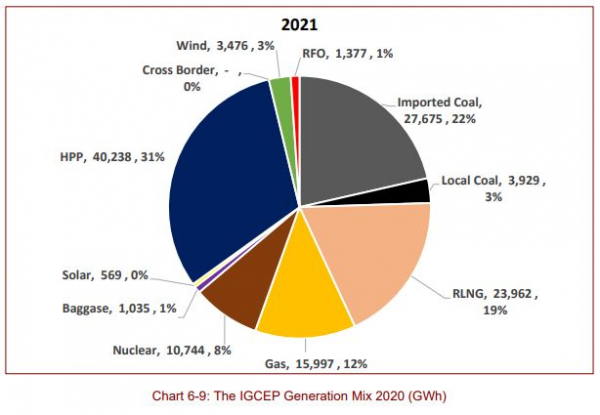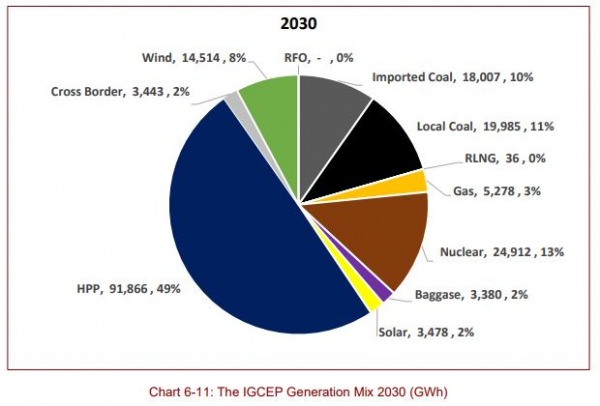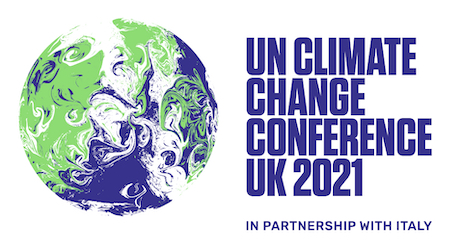
I last wrote about a COP in early 2020. That was COP25, held in Madrid. Much has happened since then. The world has forcefully experienced many of the impacts of global warming, including heat waves, flooding, droughts, and wildfires. Renewable energy and electric vehicles have seen increased uptake. Large investors and banks have begun to divest from fossil fuels, and insurance companies and big corporations have started to incorporate climate risks. A pandemic has swept (is sweeping) the planet, shining a light on economic inequality. And widely recognized organizations including the International Energy Agency (IEA), the United Nations (UN), and the World Health Organization (WHO) have written compelling reports about the urgency of global warming and the costs of doing nothing. (2)
This graphic from the IEA report is a nice summary of where we are right now. A pathway designed to bring us to net zero emissions by 2050, giving us an even chance of limiting global warming to 1.5 C, is shown (bottom of the green wedge, “Net Zero by 2050”). You can also see how far our current pledges (bottom of yellow) and current policies (bottom of blue) are getting us.
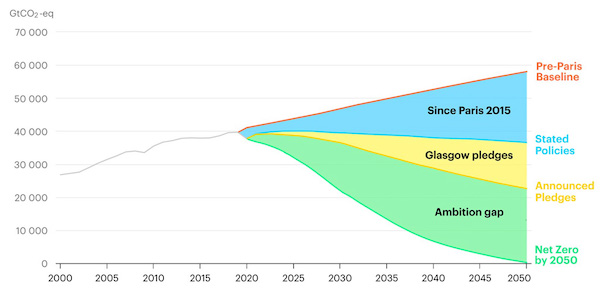
There is a large gap between country policies, country pledges, and where we need to be to stay below 1.5 C. Source: IEA World Energy Outlook 2021 via CarbonBrief
The Paris agreement was a great start, but it does not go far enough to keep us below 1.5 C. Our pledges are inadequate and the policies we have on the books to support those pledges are even more inadequate. In fact, if you look at policies only, IEA’s analysis shows that the global average temperature will be at 2.6 C above pre-industrial levels by 2100 and still rising.
The United States provides a good example of the gap between pledge and policy. We recently announced a plan to reduce emissions by 50% from 2005 levels by 2030. However, West Virginia Senator Joe Manchin and Republicans are doing their best to prevent us from establishing clean-electricity policies that will enable us to achieve that pledge. With Congress hamstrung by fossil interests, it will fall to federal and state regulators to establish review-proof regulations that will clean up our power sector.
The IEA report emphasizes the importance of policies to back up the pledges: “Clear signals and direction from policy makers are essential. If the road ahead is paved only with good intentions, then it will be a bumpy ride indeed.”
Ambition
The gaps between a 1.5 C path and our pledges, and between our pledges and our policies, are why we look to this COP 26 meeting for increased “ambition” in the national pledges along with policies to back that up. This is especially important for the biggest emitters. Models suggest that we need to approximately halve our emissions by 2030 and be net-zero by 2050 in order to stay under 1.5 degrees C of warming. Look for pledges (and policies!) along those lines. What policies will the US announce to give the world confidence that it can hit its goal to reduce emissions 50% below 2005 levels by 2030? China has announced a goal to be carbon neutral by 2060, but do they have a nearer-term goal other than to hit peak use before 2030? Japan has announced a 46% reduction from 2013 levels by 2030. What will we hear from Australia? India? Russia? I am also interested in signals from diplomats on how pressure will be applied where gaps continue to exist.
Financial Commitment
A second thing to look for is financial commitment from developed countries. In the wake of extreme pandemic inequality, there is a lot of interest in ensuring a just transition to a clean energy system. Developed countries have benefited from polluting the atmosphere, and there has long been pressure on them (us) to offset some of the damages from climate change and to support low-emission development in developing economies. In 2009, as part of the Copenhagen Accord, developed nations promised to be donating $100B each year to a “Green Climate Fund” by 2020, but contributions to date have fallen short. The degree of shortfall is in dispute because countries are (for example) counting loans as donations. What will the likes of the US, EU, Australia, and Japan pony up, and will we clarify expectations to avoid dodgy accounting?
Fossil Phaseout
The IEA report is clear that fossil fuel use needs to drop off quickly, peaking in 2025 to hit even our (inadequate) goals.
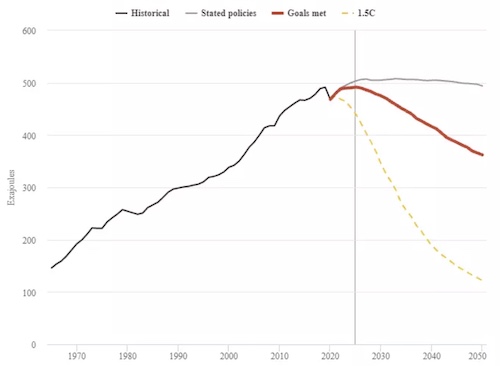
Fossil fuel use needs to peak asap to stay below 1.5 C (yellow dashed line). Our stated goals for fossil use are not enough (red line), and the policies we have in place only stabilize use for the coming decades (gray line). Source: CarbonBrief using data from IEA’s World Energy Outlook 2021 report.
Yet the world currently plans to produce far more than we should be using.
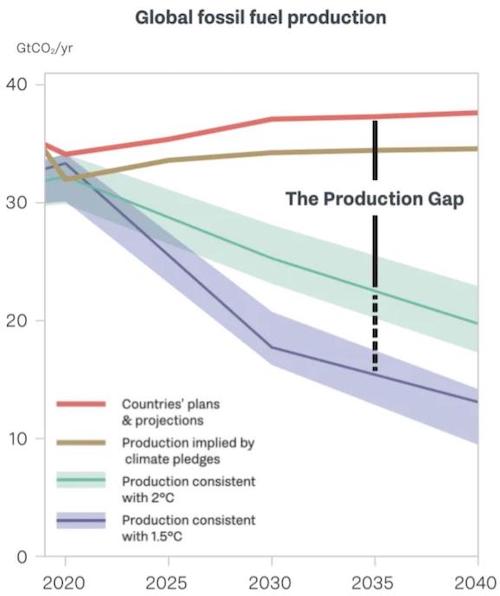
The world is planning to produce far more fossil fuel that we should need to stay below 1.5 or even 2 C. Source: United Nations 2021 Production Gap report
The United States is the world’s largest producer of oil and gas, and one of the largest of coal. IEA’s projections show oil and gas production increasing to 17% and 12% above 2019 levels by 2030, with gas continuing to increase beyond that. Coal’s decline stagnates without effective policies to close down remaining plants and transition workers to new jobs.
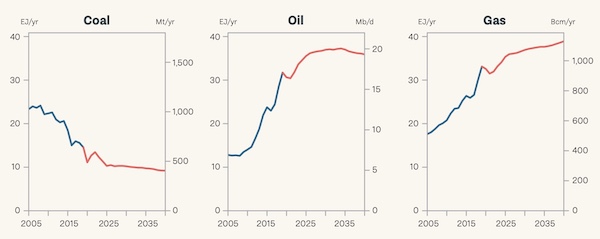
Current United States policies have us continuing to increase production of oil and gas through 2030 and even beyond (for gas), while coal decreases only slowly. This is far more than we should be producing to keep emissions below 1.5 C or even 2 C. Source: United Nations 2021 Production Gap report
Look to see whether this “production gap” is addressed in the national plans and/or at the conference more generally. How and when are Australia, Russia, India, China, the US, and Indonesia planning to phase out coal production? Saudi Arabia has said in the past that it expects to be compensated for reducing the supply of oil. How will we manage this phaseout equitably? (3)
Adaptation
Much of the time at these conferences has been spent on mitigation -- reducing carbon emissions. But if we have learned anything from the impacts of global warming we have seen over the past few years, we need to work on adaptation as well. Sea level rise will threaten coastal cities. Essential electric and transportation infrastructure will come under threat from floods, fires, and increasingly severe storms. Frequent heat waves and persistent food insecurity will endanger populations while some diseases will become more widespread. Migrations and other stressful life transitions will impact our mental and physical health. How will we harden our infrastructure, shore up our food and water supplies, facilitate necessary migrations and job transitions, and address public health issues? What level of cooperation is needed beyond financing?
It will be important to see how much focus there is on this, though it is a less hopeful topic than mitigation.
Technical Issues
Some important technical issues will be the subject of discussion at COP26. Rules related to carbon trading need to be clarified, specifically to ensure that reductions happen in the real world (not just on paper) when credits are granted. Negotiators are also looking to better align the format of pledges, for example by standardizing on timeframes. These can seem like small things, but the big accomplishment of Paris was really to get countries aligned around a shared process. The better the process, the better the outcome. (4)
Demonstrations and Protests
Finally, how will people show their interest in the proceedings and encourage the attendees to be more ambitious? Will the demonstrations be large? Will they be effective? Who will be represented? What will they call for?
The COP26 conference has been called “The world’s last, best hope to limit global warming”. Well, there is always another chance; and every tenth of a degree saved is an important improvement. But this convention comes at a critical time for increased ambition and collaboration. The IEA minces no words about what we need to see: “A laser-like focus on driving clean electrification, improving efficiency, reducing methane emissions and turbocharging innovation – accompanied by strategies to unlock capital flows in support of clean energy transitions and ensure reliability and affordability. Many of the actions described are cost-effective, and the costs of the remainder are insignificant compared with the immense risks of inaction.”
Pakistan’s commitment, I think, is a useful example because it demonstrates the near-term benefits of taking action. This very populous but poor country has pledged to:
- Shift to 55% renewables by 2025 and 60% by 2030, and ban imported coal. Renewables are cheaper, domestic energy supplies are better for national security, and it is easier to bring local electricity like hydropower to the 20-25% of the population that have no power at all right now.
- Shift to 30% electric vehicles by 2030. Pakistan has some of the worst air quality in the world. Converting to clean transportation will help them begin to improve the health and well-being of their citizens.
- Plant ten billion trees and restore nearly 1M hectares of forest. This initiative will, where successful, make land more resilient and useful, create jobs, and provide shade and habitat. While water may be an issue and all trees won’t thrive, the country is making a convincing start at reversing decades of deforestation.
Pakistan is one of the most populous countries on the planet, and one of the most vulnerable to climate change. It faces increased heat waves, intensifying cyclones and flooding, and melting glaciers. The nation and its people have rallied around these goals in anticipation of the clear, near-term benefits they provide.
The world as a whole has similar opportunity. In the IEA’s net-zero pathway everyone has access to energy by 2030, and in just ten years we see 2.2 million fewer premature deaths from air pollution. Energy use drops 8% by 2050 although the population grows by two billion, and GDP doubles at the same time. This pathway requires unprecedented and immediate international commitment and cooperation, but imo it is compelling.
Will the nations of the world commit to a more sustainable planet in Glasgow?
Notes and References
1. Technically speaking it’s Year Six, but last year was cancelled due to the pandemic.
2. Many reports are coming out in the lead-up to COP26 in addition to those mentioned above. The White House recently released several related to the national security implications of climate change. The Lancet medical journal released a report on the costs to human health, calling climate change “the greatest global health threat facing the world in the 21st century”.
3. This chart blows my mind. We continue to spend more public money on fossil fuel than on clean energy.

Source: United Nations 2021 Production Gap report
4. You can find a good description of the outstanding carbon market issues here.
5. The UN lists the most recent NDC contributions here, and the Climate Action Tracker has some easy-to-read analysis of them for select countries here. (Strangely, though, India is not one of the countries they cover.)
Current Climate Data (September 2021)
Global impacts, US impacts, CO2 metric, Climate dashboard (updated annually)
This week’s item of interest is a massive renewable build in China. From CarbonBrief's 10/21 China Briefing: "China is bulk-building “new energy” projects in its vast deserts, according to state media. The province of Gansu in north-western China started the construction of 39 renewable energy projects simultaneously last Friday, reported CGTN. With a combined investment of $10.8bn, these projects involve solar, wind and solar-thermal power plants, as well as energy storage facilities, the official channel said. Their total installed capacity is expected to reach 12.85 gigawatts (GW), the outlet added. Local officials also hope that these projects can help them prevent and control desertification, China News Service reported (link in Mandarin). " For reference, 13 GW is about the capacity of all the solar power in California (14 GW not including rooftop).
Comment Guidelines
I hope that your contributions will be an important part of this blog. To keep the discussion productive, please adhere to these guidelines or your comment may be moderated:
- Avoid disrespectful, disparaging, snide, angry, or ad hominem comments.
- Stay fact-based and refer to reputable sources.
- Stay on topic.
- In general, maintain this as a welcoming space for all readers.
Comments that are written in batches by people/bots from far outside of this community are being removed.




